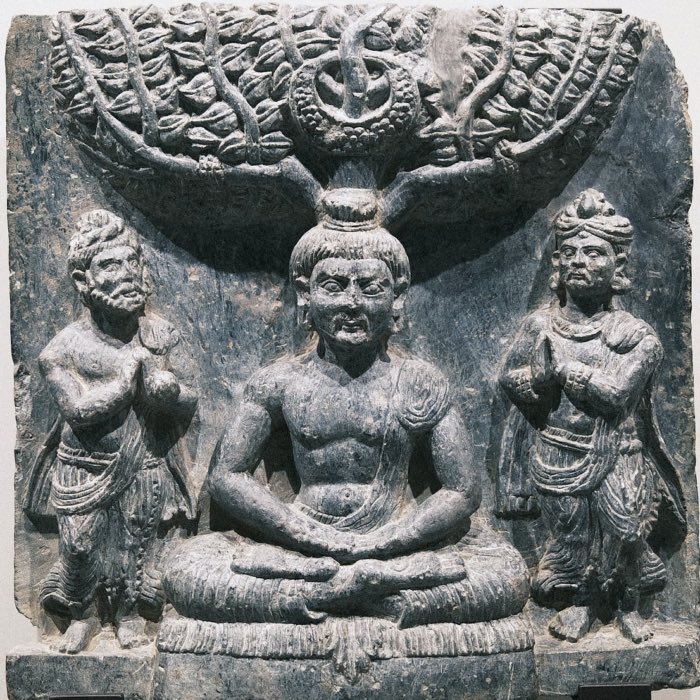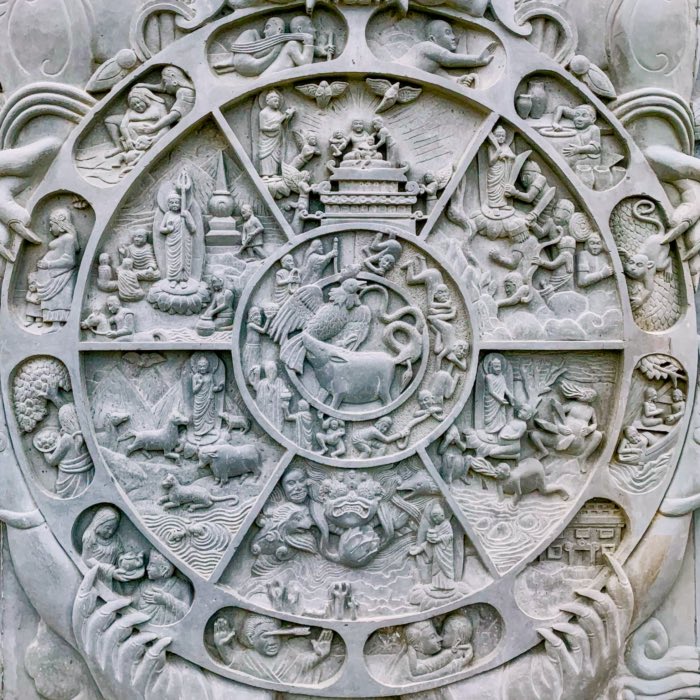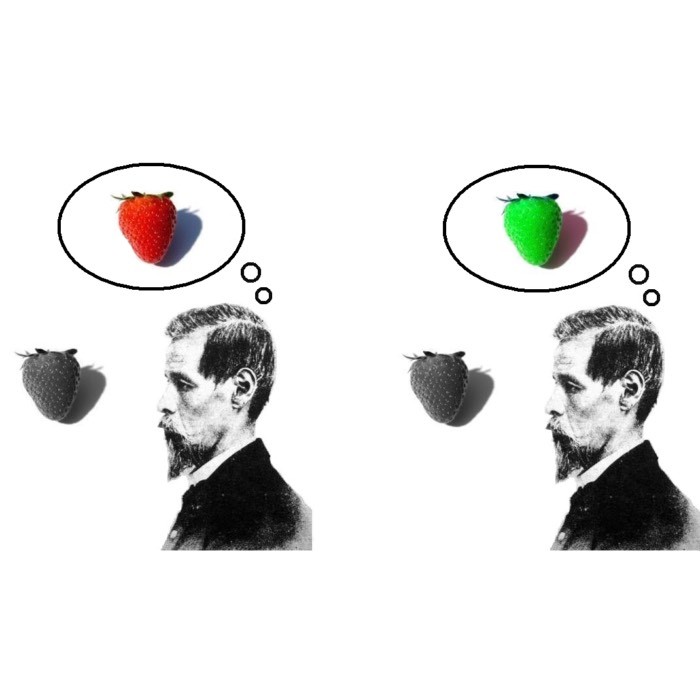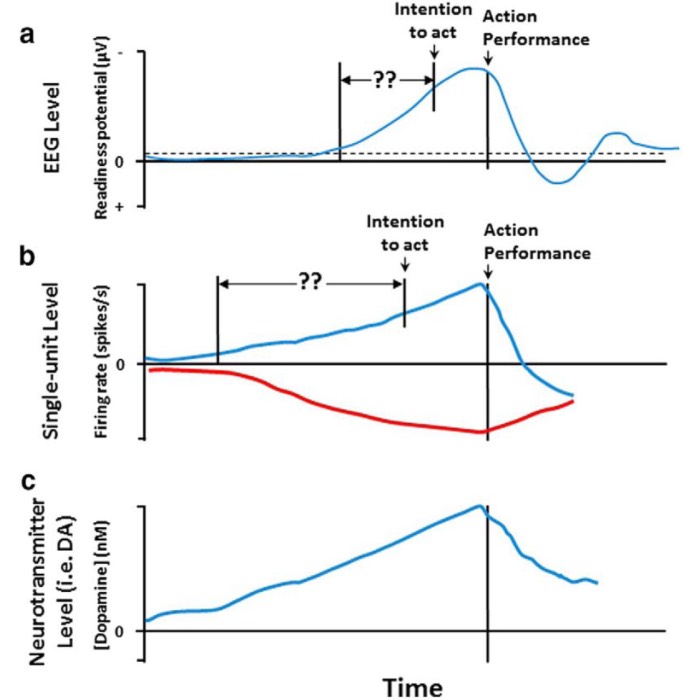Buddhism and quantum physics: Parallels, projections, and problems
The 20th century saw an emerging and sometimes enthusiastic dialogue between modern physics and Eastern philosophical traditions, with particular emphasis on Buddhism. The motivation for this comparison stems largely from the revolutionary implications of quantum theory, which appeared to undermine the mechanistic, deterministic worldview of classical physics. The counterintuitive nature of quantum mechanics, with its notions of uncertainty, superposition, and entanglement, led many physicists and thinkers to seek conceptual frameworks outside the boundaries of Western rationalism. For some, Buddhist ideas about interdependence, non-self, and emptiness seemed to echo the philosophical implications of the quantum world.

Probability density clouds for an electron in the hydrogen atom, shown for increasing principal quantum numbers $n$ from top to bottom and for different orbital types across the bottom row ($s$, $p$, $d$). The colored lobes do not represent solid particles, but regions where a position measurement is more or less likely, so that what we call an “electron” appears as a structured pattern in a probabilistic field rather than a tiny localized object. This quantum picture of matter as relational and distributional, rather than as composed of intrinsically independent substances, provides a natural point of contact with the Buddhist analysis of phenomena as conditioned, empty of fixed essence, and defined by their dependencies. Source: Wikimedia Commonsꜛ (license: CC BY-SA 4.0)
Historically, this dialogue was first championed by physicists such as Niels Bohr and Erwin Schrödinger, who expressed philosophical sympathy with Eastern modes of thought. In the 1970s, Fritjof Capra’s influential book The Tao of Physics brought these ideas to a broader public, arguing that modern physics and mystical traditions share a common insight into the interconnected and dynamic nature of reality. While Capra’s work sparked widespread interest, it also drew criticism for overstating the equivalence between scientific and spiritual perspectives.
Today, the intersection between Buddhism and quantum physics continues to be a subject of curiosity and debate. However, it is important to clarify the scope and limits of this inquiry. This post does not aim to equate the ontological claims of Buddhist philosophy with the mathematical formalism of quantum physics (at least not at all). Rather, it seeks to explore where meaningful parallels might exist, where metaphorical comparisons are frequently made (sometimes without sufficient rigor), and what potential value lies in juxtaposing these two powerful but distinct ways of understanding reality. The central question is not whether Buddhism can explain quantum physics or vice versa, but whether each tradition can inform the other in a philosophically responsible and intellectually fruitful way.
Core principles in Buddhist philosophy
Dependent origination and emptiness (paṭiccasamuppāda, śūnyatā)
In Buddhist philosophy, the principle of dependent origination (paṭiccasamuppāda) is a foundational insight that expresses the interdependent, contingent nature of all phenomena. According to this view, nothing arises independently; everything exists in a web of causal relationships. A mental state, a physical object, a thought, a sensation — all arise only when the necessary conditions are present and cease when those conditions dissolve. There is no permanent essence or substratum underlying any phenomenon.
The concept of emptiness (śūnyatā) is a deepening of this principle. Prominently developed in Madhyamaka philosophy by Nāgārjuna, emptiness does not mean that things do not exist at all; rather, it means that things do not exist inherently or independently. They exist conventionally, as part of dynamic interrelations, but lack any intrinsic, self-sustaining essence. Even causality itself is empty in this view, not in the sense of being illusory or false, but in the sense of being contextually constructed and not rooted in an absolute metaphysical ground.
This framework leads to a radically relational ontology: things do not possess identity in isolation but only through their mutual dependencies. A leaf is not simply a leaf; it is also sun, soil, water, and tree. This idea has profound implications for understanding not only physical phenomena but also mind, identity, and knowledge itself.
In the context of a dialogue with quantum physics, dependent origination and emptiness challenge classical notions of causality, substance, and separability. The Buddhist view encourages us to reconsider the very assumptions underlying objectivity and discreteness. A task that also lies at the heart of quantum theoretical reflection.
Impermanence and non-self (anicca, anattā)
In the Buddhist view, impermanence (anicca) is a fundamental characteristic of all conditioned phenomena. Everything that arises, whether it is a thought, emotion, perception, or material form, inevitably changes, decays, and passes away. There is no enduring essence behind any experience. This insight is not merely observational but carries profound existential implications: clinging to what is impermanent leads to suffering because it inevitably results in frustration and loss.
Closely tied to impermanence is the principle of non-self (anattā). Siddhartha Gautama emphasized that what we conventionally take to be the “self” is actually a collection of ever-changing processes, namely, the Five Aggregates (khandha): form, feeling, perception, mental formations, and consciousness. None of these components, nor their sum, can be identified as a fixed, independent self.
Buddhist analysis teaches that our sense of identity is a mental construction maintained through memory, habit, and grasping. It arises through interdependent conditions and has no inherent existence. This idea challenges deeply rooted intuitions about personal continuity and agency.
In dialogue with quantum physics, these insights resonate with the notion that what appears solid and enduring is, at a deeper level, a flux of relations and probabilities. Just as particles are not fixed substances but probabilistic excitations within fields, the self is not a stable essence but a temporary configuration within a processual matrix of causes and conditions.
Epistemology: Direct experience, conventional and ultimate truths
Buddhist epistemology operates through a nuanced distinction between two levels of truth: conventional truth (saṃvṛti-satya) and ultimate truth (paramārtha-satya). Conventional truth refers to the everyday framework of language, categories, and socially constructed distinctions through which humans navigate the world. It includes concepts like time, space, self, and objects. Practical and necessary for communication and survival, but ultimately provisional and context-bound.
Ultimate truth, by contrast, points to the direct experiential realization of reality as it truly is: non-dual, impermanent, and devoid of inherent essence. According to this view, the dualistic framework we normally employ — subject versus object, mind versus matter — is a cognitive overlay that obscures the actual nature of experience. In deep states of meditative absorption and insight (vipassanā), practitioners can perceive the moment-to-moment arising and ceasing of phenomena without clinging to fixed identities or categories.
Central to this process is prajñā (wisdom or insight), which arises not from abstract reasoning or speculative metaphysics, but from direct contemplative observation. While reasoning and conceptual analysis have their place in Buddhist scholastic traditions, the ultimate goal is experiential understanding that transforms perception and liberates the mind from suffering.
This approach to knowledge stands in contrast to the dominant scientific epistemology, which relies on third-person observation, quantification, and repeatability. However, it also invites dialogue: just as quantum physics challenges assumptions about observer-independent reality and emphasizes relational knowledge, Buddhist thought calls attention to the constructed nature of conceptual frameworks and the necessity of direct, embodied experience as a basis for understanding.
Key concepts in Quantum Physics
In contrast to the classical physics of Newton and Einstein, which described a deterministic universe governed by fixed laws, quantum mechanics introduces a probabilistic framework that challenges our intuitions about reality. The following key concepts are central to understanding quantum theory:
Superposition, entanglement, and uncertainty
Quantum mechanics departs radically from classical physics in its description of matter at the smallest scales. One of its foundational concepts is superposition: the idea that a quantum system can exist in multiple potential states simultaneously. Mathematically, the state of a quantum system is described by a wave function $\Psi$, which is a linear combination of basis states. For example, a qubit in superposition can be written as:
\[\Psi = \alpha \lvert 0 \rangle + \beta \lvert 1 \rangle\]where $\lvert 0 \rangle$ and $\lvert 1 \rangle$ represent possible states, and $\alpha$ and $\beta$ are complex probability amplitudes such that $\lvert \alpha \rvert^2 + \lvert \beta \rvert^2 = 1$.
Entanglement is another phenomenon unique to quantum systems, in which particles that have interacted become linked such that the state of one cannot be described independently of the state of the other, even when separated by vast distances. A maximally entangled state of two qubits can be written as:
\[\Psi = \frac{1}{\sqrt{2}} \left( \lvert 00 \rangle + \lvert 11 \rangle \right)\]This implies that a measurement on one particle instantly determines the outcome for the other, defying classical intuitions of locality. While Einstein famously referred to this as “spooky action at a distance,” experimental confirmation of Bell’s inequalities has validated entanglement as a real, physical phenomenon.
The Heisenberg uncertainty principle adds a further layer of indeterminacy. It states that certain pairs of physical properties, such as position x and momentum p, cannot be simultaneously known to arbitrary precision. This is expressed as:
\[\Delta x \cdot \Delta p \geq \frac{\hbar}{2}\]This inherent limitation is not due to technological inadequacy but reflects a fundamental property of quantum systems. It challenges classical determinism and suggests that reality at the quantum level is probabilistic, not fixed.
The measurement problem and observer effect
The measurement problem arises from the question of how and when a quantum system transitions from a superposition of states into a definite outcome. According to the Copenhagen interpretation, this collapse occurs upon measurement, yet the mechanism remains poorly understood. This has led to ongoing debate about the role of the observer in quantum theory.
Some interpretations suggest that the observer’s knowledge or consciousness causes the collapse, while others, such as decoherence theory, attribute the transition to interactions with the environment. Regardless of the interpretation, the observer effect highlights a deep ambiguity in separating subject and object in quantum physics.
Quantum field theory and relational interpretations
Quantum field theory (QFT), the most comprehensive framework for modern physics, describes particles not as fundamental entities but as excitations in underlying fields. Every type of particle corresponds to a field permeating all of space, and interactions are modeled through field couplings.
Furthermore, relational interpretations of quantum mechanics, such as Carlo Rovelli’s Relational Quantum Mechanics, argue that physical quantities only have meaning in the context of interactions. There is no absolute, observer-independent state of a system; rather, reality is constituted through networks of relations. This emphasis on contextuality and relational existence opens potential avenues of dialogue with Buddhist metaphysical models that similarly reject essentialism and posit dependent co-arising as a core feature of reality.
Parallels often drawn between Buddhism and quantum theory
In the popular discourse surrounding the intersection of Buddhism and quantum physics, several parallels are frequently drawn. These comparisons often highlight shared themes of interdependence, non-locality, and the role of the observer. However, it is crucial to approach these parallels with caution, as they can easily lead to oversimplification or misinterpretation.
Non-locality and interdependence
Quantum entanglement is often cited in popular discussions as an analog to the Buddhist concept of interdependence, though the two operate in distinct domains. In quantum mechanics, entanglement refers to a specific mathematical and physical relationship: once two particles interact, their quantum states become correlated such that the measurement of one instantaneously affects the state of the other, regardless of spatial separation. This phenomenon is experimentally observable and described precisely by quantum formalism.
Buddhist interdependence, by contrast, is a metaphysical and phenomenological claim: it asserts that all phenomena arise in dependence upon other phenomena, and that no entity has an intrinsic, independent existence. This is not limited to particles or objects but includes mental states, perceptions, and identities. Everything is conditioned, co-arising, and lacking in self-nature.
The similarity lies in the shared challenge both pose to classical notions of separability and isolated substances. However, while entanglement is a measurable correlation within the framework of quantum theory, interdependence is a broader ontological principle. The risk lies in conflating formal physical relationships with existential insights. Nevertheless, the resonance between these perspectives invites reflection on the possibility that the world is less made up of things than of relations, a view that is both scientifically provocative and philosophically profound.
Emptiness and quantum indeterminacy
Quantum mechanics describes physical systems not as composed of fixed entities with intrinsic properties, but rather as probabilistic distributions encoded in a wave function. Until measurement, a particle does not have a definite position or momentum, but exists in a range of possible states. This indeterminacy has led some to draw comparisons with the Buddhist concept of śūnyatā, or emptiness, which holds that all phenomena are devoid of inherent, independent essence.
In both frameworks, the notion of a self-contained substance gives way to a relational and process-based view of reality. A quantum particle has no isolated identity until it interacts with something else; similarly, in Buddhism, a person or object arises only in dependence upon conditions and does not possess an immutable core.
Yet, these parallels should be approached with careful nuance. Quantum indeterminacy is a precise physical phenomenon described mathematically and tested experimentally. Emptiness, in contrast, is a philosophical and soteriological insight into the nature of experience and suffering. While both question the idea of inherent existence, they do so within different epistemological and methodological contexts.
Nevertheless, the resonance between the two points to a shared challenge to substance ontology and invites reflection on a view of reality grounded in interrelation, contingency, and impermanence rather than solidity and certainty.
The role of the observer in quantum measurement and Buddhist awareness
In both quantum physics and Buddhist contemplative traditions, the observer plays an unexpectedly central role in shaping the character of what is observed. In quantum mechanics, this is most famously illustrated in the measurement problem. Prior to observation, a quantum system exists in a superposition of possible states, described by a wave function. The act of measurement appears to ‘collapse’ the wave function into a definite outcome. This has led to intense debate over whether consciousness itself plays a causal role in this process, or whether the apparent collapse is best understood through environmental decoherence or other interpretations. Nevertheless, the idea that measurement influences reality undermines classical notions of an observer-independent world.
In Buddhist practice, observation is not merely a neutral act of witnessing but a transformative process. Through meditative awareness, practitioners develop refined attention to the arising and passing of mental and physical phenomena. This cultivation of mindfulness (sati) reveals how perception is not passive reception but an active construction shaped by intention, habit, and delusion. In advanced states of meditative insight, the boundary between observer and observed may dissolve, revealing the contingent and constructed nature of both.
Though quantum mechanics and Buddhist awareness differ in aims and methods, one seeks predictive power and empirical verification, the other insight and liberation, they converge in unsettling the assumption of an independent, objective reality. Both perspectives imply that the act of observation cannot be cleanly separated from what is observed, and that reality may not be fully intelligible without acknowledging the role of the knower.
Critical assessment of the parallels
While the conceptual resonances between Buddhism and quantum physics are intriguing, they must be evaluated with care and intellectual discipline. A key distinction lies in the goals and methodologies of each domain. Quantum theory is an empirical science grounded in mathematical formalism, experimental reproducibility, and predictive modeling. Its objective is to describe the behavior of physical systems and to refine our understanding of matter, energy, and fundamental forces. By contrast, Buddhism is a soteriological tradition. Its purpose is to understand and alleviate suffering through ethical conduct, mental cultivation, and insight into the nature of experience. While both are concerned with the nature of reality, they do so from fundamentally different vantage points.
This divergence in purpose and method leads to a common pitfall: the conflation of metaphorical similarities with ontological equivalence. The fact that both quantum physics and Buddhist philosophy challenge classical ideas of substance and separability does not mean they are making the same claims. Quantum indeterminacy and Buddhist emptiness may sound alike, but one describes a probabilistic feature of wave functions, while the other articulates a philosophical and existential stance on the lack of inherent essence in all phenomena. To equate them ontologically risks flattening the rich complexities of both traditions.
A related danger is the projection of spiritual meaning onto technical physics, or vice versa. When Buddhist terms are mapped uncritically onto quantum concepts, or when quantum equations are used to validate spiritual insight, the result may be a superficial synthesis that satisfies poetic intuition but lacks rigor. This has led to a proliferation of pseudoscientific claims that misuse both scientific and philosophical authority. Responsible dialogue must resist the temptation to romanticize quantum theory as mystical, or to recast Buddhism as proto-scientific.
Nevertheless, critical assessment does not preclude constructive engagement. By recognizing the boundaries and distinctive strengths of each domain, scholars and practitioners can explore meaningful dialogue without collapsing difference into sameness.
Responsible philosophical dialogue
The encounter between Buddhism and quantum physics is not a matter of merging two disparate traditions into a single framework, but rather an opportunity for responsible philosophical dialogue. This dialogue can yield valuable insights into the nature of reality, observation, and relationality, while respecting the distinct methodologies and aims of each field.
Complementarity without conflation
Buddhism and quantum physics, despite operating in different domains, both disrupt the assumptions of classical realism. Quantum mechanics undermines the view of a mind-independent, fully determinate universe by revealing the probabilistic, context-dependent nature of physical systems. Similarly, Buddhism challenges the reification of fixed identities and substances, emphasizing impermanence and conditionality as core aspects of reality.
These parallel disruptions offer a meaningful basis for complementarity, but only when each field is understood on its own terms. The insights of one should not be used to validate or replace the other. Instead, dialogue is most fruitful when it cultivates intellectual humility, avoids superficial conflation, and acknowledges the distinct methodologies and aims of science and contemplative philosophy. A responsible exchange allows each to illuminate blind spots in the other, without forcing a merger of fundamentally different paradigms.
Buddhist contributions to philosophy of science
Buddhism contributes to the philosophy of science by offering a process-oriented, relational ontology that contrasts sharply with substance-based metaphysics. Its emphasis on conditionality, impermanence, and the constructed nature of subject-object distinctions provides a framework for rethinking fundamental assumptions in scientific epistemology. Particularly in light of quantum mechanics’ challenges to classical realism and observer-independent objectivity, Buddhist thought supplies philosophical resources for understanding reality as context-dependent and co-arising. Additionally, the Buddhist focus on first-person methodologies, such as meditative investigation, invites consideration of phenomenological approaches alongside third-person scientific inquiry. This opens possibilities for a more integrated view of knowledge that respects both empirical rigor and experiential depth.
Shared insights on relationality and the limits of objective knowledge
Both Buddhism and quantum theory converge in undermining the assumption that objects possess inherent, observer-independent existence. In quantum physics, the relational nature of properties, such as position, spin, or momentum, suggests that physical attributes do not exist in isolation but only acquire definite values through specific interactions or measurements. This insight has led to interpretations of quantum mechanics that stress the interdependence of observer and system.
Similarly, Buddhist philosophy maintains that all phenomena are empty of inherent essence and arise only in dependence on other factors, including perception and cognition. The self, the world, and even conceptual categories are seen as contingent constructs arising within a web of causes and conditions. From this standpoint, the observer and the observed are not two fundamentally separate entities but co-arise as part of a relational process.
Together, these perspectives question the foundations of classical objectivism and advocate for a view of knowledge that is context-bound, participatory, and dynamic. Rather than asserting that quantum theory and Buddhism say the same thing, it is more accurate, and more fruitful, to say that they challenge us in similar ways to rethink the boundaries between subject and object, and to appreciate the limits and responsibilities involved in any act of observation.
Conclusion
The encounter between Buddhism and quantum physics is neither a fusion of science and spirituality nor a matter of reducing one to the terms of the other. Instead, it represents a generative dialogue between two traditions that, from vastly different starting points, arrive at provocatively similar insights about the nature of reality, observation, and relationality. Buddhism, grounded in contemplative insight and soteriological intent, and quantum physics, rooted in empirical investigation and mathematical formalism, both dismantle the view of an objective, observer-independent world composed of discrete, inherently existing entities.
What can be learned across traditions is not a shared ontology but a shared capacity to destabilize habitual assumptions. Buddhism invites us to see experience as conditioned, impermanent, and selfless, while quantum theory reveals the probabilistic and relational character of physical systems. These insights may not map neatly onto each other, but their juxtaposition illuminates the limits of reductionism and affirms the importance of context, perspective, and process in our understanding of the world.
Crucially, this comparative exercise fosters intellectual humility. It reminds us that knowledge is shaped by the frameworks we inhabit and that no single tradition holds a monopoly on insight. Interdisciplinary inquiry, when approached without conflation or projection, can help cultivate a more nuanced, flexible, and ethically aware understanding of existence, one that honors both the rigor of science and the depth of contemplative wisdom.
References and further reading
- Bohr, Niels, Atomic Theory and the Description of Nature: Four Essays with an Introductory Survey, 2011 (original publication: 1934), Cambridge University Press, ISBN: 978-1107628052
- Capra, Fritjof, The Tao of Physics: An exploration of the parallels between modern physics and Eastern mysticism, 2025 (original publication: 1975), Shambhala, ISBN: 978-1645472902
- Schrödinger, Erwin, What is Life? The physical aspect of the living cell, 1968 (original publication: 1944), Cambridge University Press, ISBN: 978-0521093972
- Varela, Francisco J.; Thompson, Evan; Rosch, Eleanor, The embodied mind: Cognitive science and human experience, 1991, MIT Press, ISBN: 9780262285476, doi: 10.7551/mitpress/6730.001.0001ꜛ
- Thompson, Evan, Mind in life: Biology, phenomenology, and the sciences of mind, 2007, Harvard University Press, ISBN: 978-0-674-02511-0, online PDFꜛ
- Garfield, Jay L., Engaging Buddhism: Why it matters to philosophy, 2015, ACADEMIC, ISBN: 978-0190204334, online PDFꜛ
- Wallace, B. Alan, Hidden dimensions: The unification of physics and consciousness, 2007, Columbia University Press, ISBN: 9780231141512ꜛ
- Zeilinger, Anton, Dance of the Photons: From Einstein to Quantum Teleportation, 2010, Farrar, Straus and Giroux, ISBN: 978-0374239664
- Rovelli, Carlo, Helgoland: Making sense of the quantum revolution, 2021, Riverhead Books, ISBN: 978-0593328880
- Zeilinger, Anton, A foundational principle for quantum mechanics, 1999, Foundations of Physics, 29(4): 631–643, doi: 10.1023/A:1018820410908
- Stapp, H. P., Mind, matter, and quantum mechanics, 2009 (original publication: 1993), Springer, ISBN: 978-3540896531
- Bitbol, M., Science as if situation mattered, 2002, Phenomenology and the Cognitive Sciences 1, 181–224, doi: 10.1023/A:1020328422900ꜛ
- Barad, K., Meeting the universe halfway: Quantum physics and the entanglement of matter and meaning, 2007, MNG University Presses, ISBN: 978-0822339175
























comments